Impacts of Cigarettes and Marijuana Usage on Teens in the U.S.A.
VerifiedAdded on 2023/06/13
|11
|2228
|279
Report
AI Summary
This report analyzes the impacts of cigarette and marijuana use among teens in the U.S.A., addressing parental concerns and the negative societal impact. Key issues explored include the adverse health effects on developing brains, leading to physical and mental health problems like liver damage, anxiety, and academic decline. The report references statistical data showing high marijuana exposure among teens and discusses factors like peer pressure, academic problems, and family issues contributing to substance abuse. A newspaper review highlights decreasing trends in teen smoking and drinking but a stable marijuana usage, especially vaping. The report concludes that despite some decline in overall teen drug use, the issue remains significant, requiring proper guidance through counseling and rehabilitation programs. Desklib offers students access to similar reports and solved assignments for academic support.
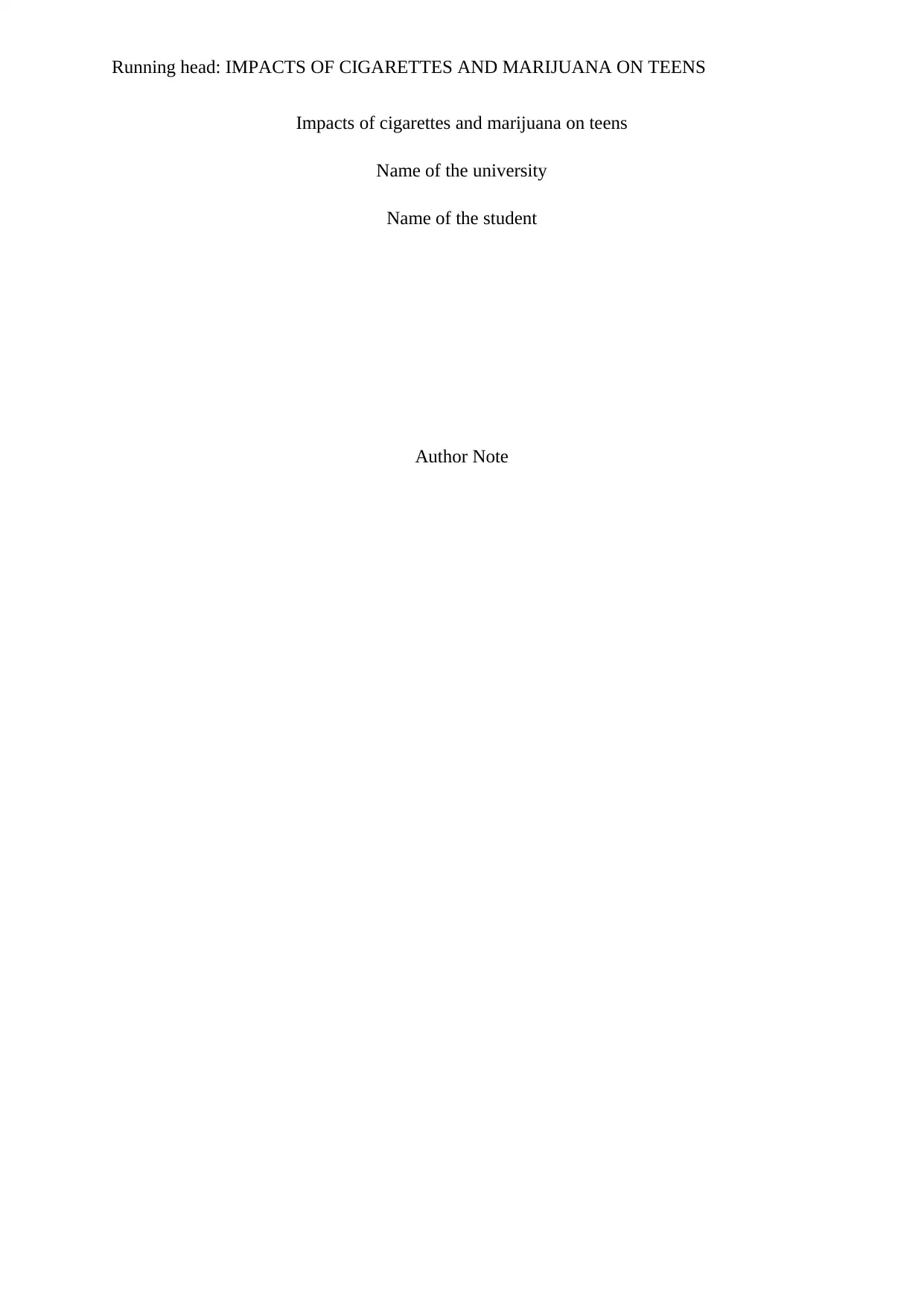
Running head: IMPACTS OF CIGARETTES AND MARIJUANA ON TEENS
Impacts of cigarettes and marijuana on teens
Name of the university
Name of the student
Author Note
Impacts of cigarettes and marijuana on teens
Name of the university
Name of the student
Author Note
Paraphrase This Document
Need a fresh take? Get an instant paraphrase of this document with our AI Paraphraser
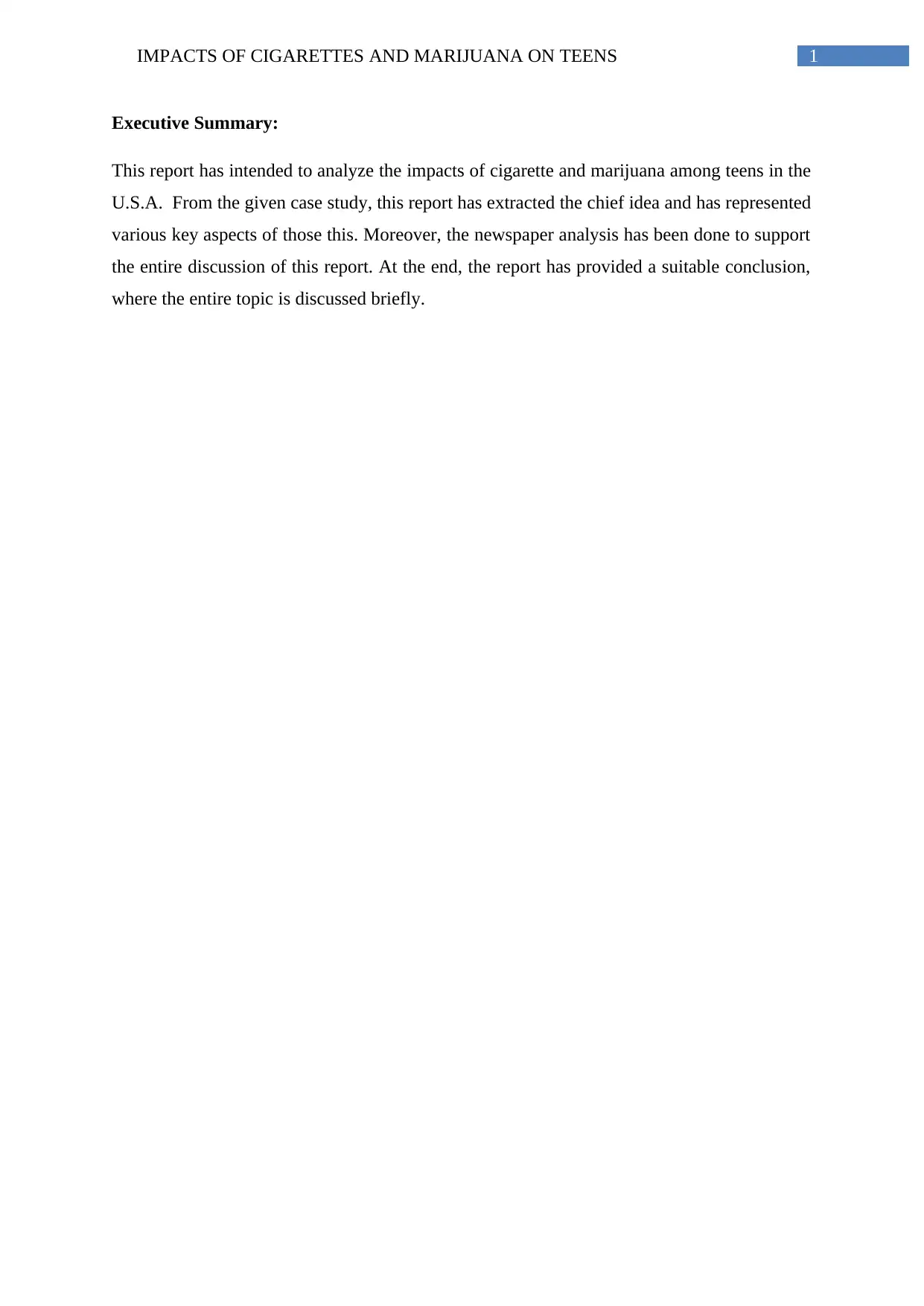
1IMPACTS OF CIGARETTES AND MARIJUANA ON TEENS
Executive Summary:
This report has intended to analyze the impacts of cigarette and marijuana among teens in the
U.S.A. From the given case study, this report has extracted the chief idea and has represented
various key aspects of those this. Moreover, the newspaper analysis has been done to support
the entire discussion of this report. At the end, the report has provided a suitable conclusion,
where the entire topic is discussed briefly.
Executive Summary:
This report has intended to analyze the impacts of cigarette and marijuana among teens in the
U.S.A. From the given case study, this report has extracted the chief idea and has represented
various key aspects of those this. Moreover, the newspaper analysis has been done to support
the entire discussion of this report. At the end, the report has provided a suitable conclusion,
where the entire topic is discussed briefly.

2IMPACTS OF CIGARETTES AND MARIJUANA ON TEENS
Table of Contents
Introduction:...............................................................................................................................3
Key Issues:.................................................................................................................................3
Newspaper Review:...................................................................................................................5
Conclusion:................................................................................................................................8
Table of Contents
Introduction:...............................................................................................................................3
Key Issues:.................................................................................................................................3
Newspaper Review:...................................................................................................................5
Conclusion:................................................................................................................................8
⊘ This is a preview!⊘
Do you want full access?
Subscribe today to unlock all pages.

Trusted by 1+ million students worldwide
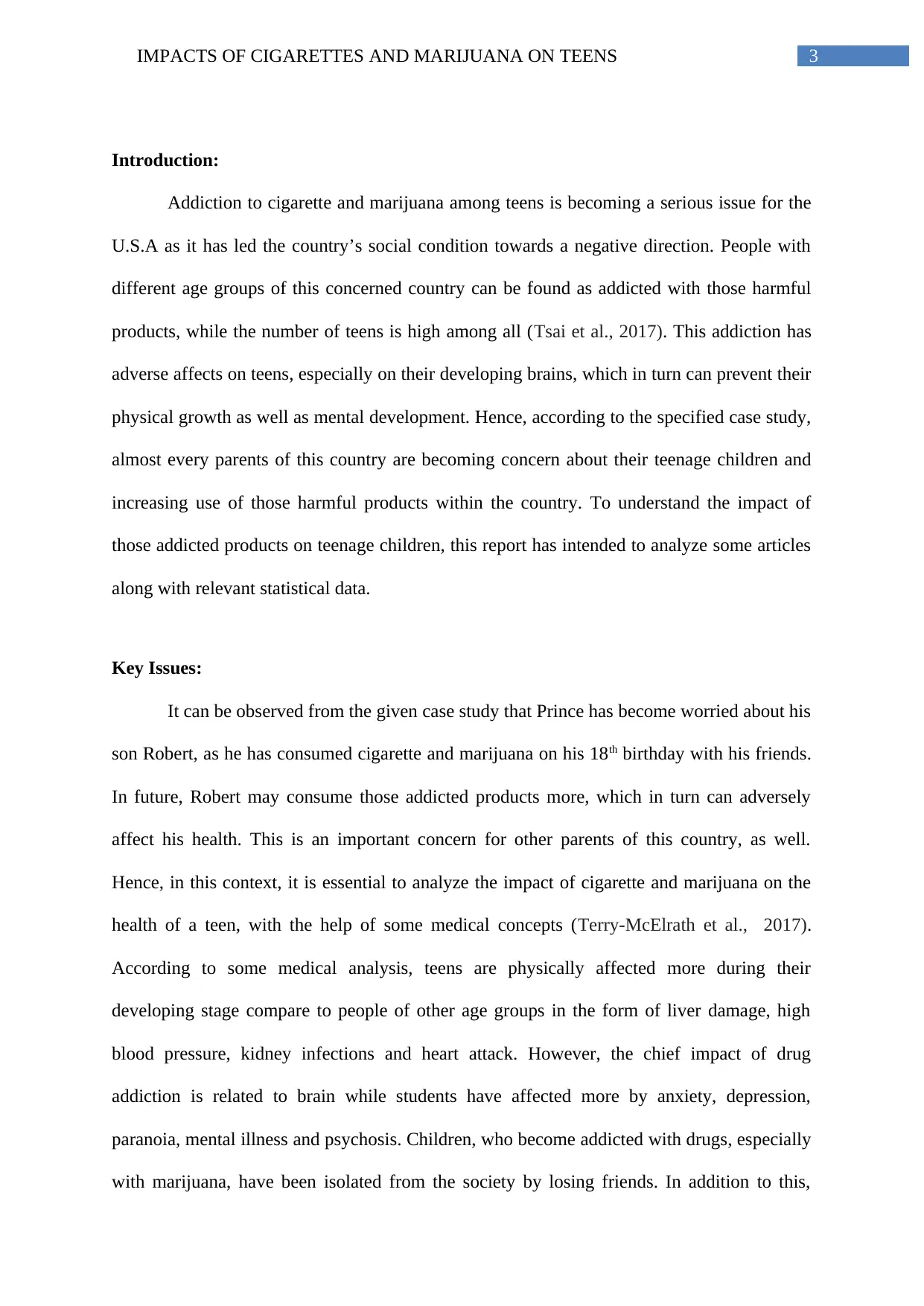
3IMPACTS OF CIGARETTES AND MARIJUANA ON TEENS
Introduction:
Addiction to cigarette and marijuana among teens is becoming a serious issue for the
U.S.A as it has led the country’s social condition towards a negative direction. People with
different age groups of this concerned country can be found as addicted with those harmful
products, while the number of teens is high among all (Tsai et al., 2017). This addiction has
adverse affects on teens, especially on their developing brains, which in turn can prevent their
physical growth as well as mental development. Hence, according to the specified case study,
almost every parents of this country are becoming concern about their teenage children and
increasing use of those harmful products within the country. To understand the impact of
those addicted products on teenage children, this report has intended to analyze some articles
along with relevant statistical data.
Key Issues:
It can be observed from the given case study that Prince has become worried about his
son Robert, as he has consumed cigarette and marijuana on his 18th birthday with his friends.
In future, Robert may consume those addicted products more, which in turn can adversely
affect his health. This is an important concern for other parents of this country, as well.
Hence, in this context, it is essential to analyze the impact of cigarette and marijuana on the
health of a teen, with the help of some medical concepts (Terry-McElrath et al., 2017).
According to some medical analysis, teens are physically affected more during their
developing stage compare to people of other age groups in the form of liver damage, high
blood pressure, kidney infections and heart attack. However, the chief impact of drug
addiction is related to brain while students have affected more by anxiety, depression,
paranoia, mental illness and psychosis. Children, who become addicted with drugs, especially
with marijuana, have been isolated from the society by losing friends. In addition to this,
Introduction:
Addiction to cigarette and marijuana among teens is becoming a serious issue for the
U.S.A as it has led the country’s social condition towards a negative direction. People with
different age groups of this concerned country can be found as addicted with those harmful
products, while the number of teens is high among all (Tsai et al., 2017). This addiction has
adverse affects on teens, especially on their developing brains, which in turn can prevent their
physical growth as well as mental development. Hence, according to the specified case study,
almost every parents of this country are becoming concern about their teenage children and
increasing use of those harmful products within the country. To understand the impact of
those addicted products on teenage children, this report has intended to analyze some articles
along with relevant statistical data.
Key Issues:
It can be observed from the given case study that Prince has become worried about his
son Robert, as he has consumed cigarette and marijuana on his 18th birthday with his friends.
In future, Robert may consume those addicted products more, which in turn can adversely
affect his health. This is an important concern for other parents of this country, as well.
Hence, in this context, it is essential to analyze the impact of cigarette and marijuana on the
health of a teen, with the help of some medical concepts (Terry-McElrath et al., 2017).
According to some medical analysis, teens are physically affected more during their
developing stage compare to people of other age groups in the form of liver damage, high
blood pressure, kidney infections and heart attack. However, the chief impact of drug
addiction is related to brain while students have affected more by anxiety, depression,
paranoia, mental illness and psychosis. Children, who become addicted with drugs, especially
with marijuana, have been isolated from the society by losing friends. In addition to this,
Paraphrase This Document
Need a fresh take? Get an instant paraphrase of this document with our AI Paraphraser
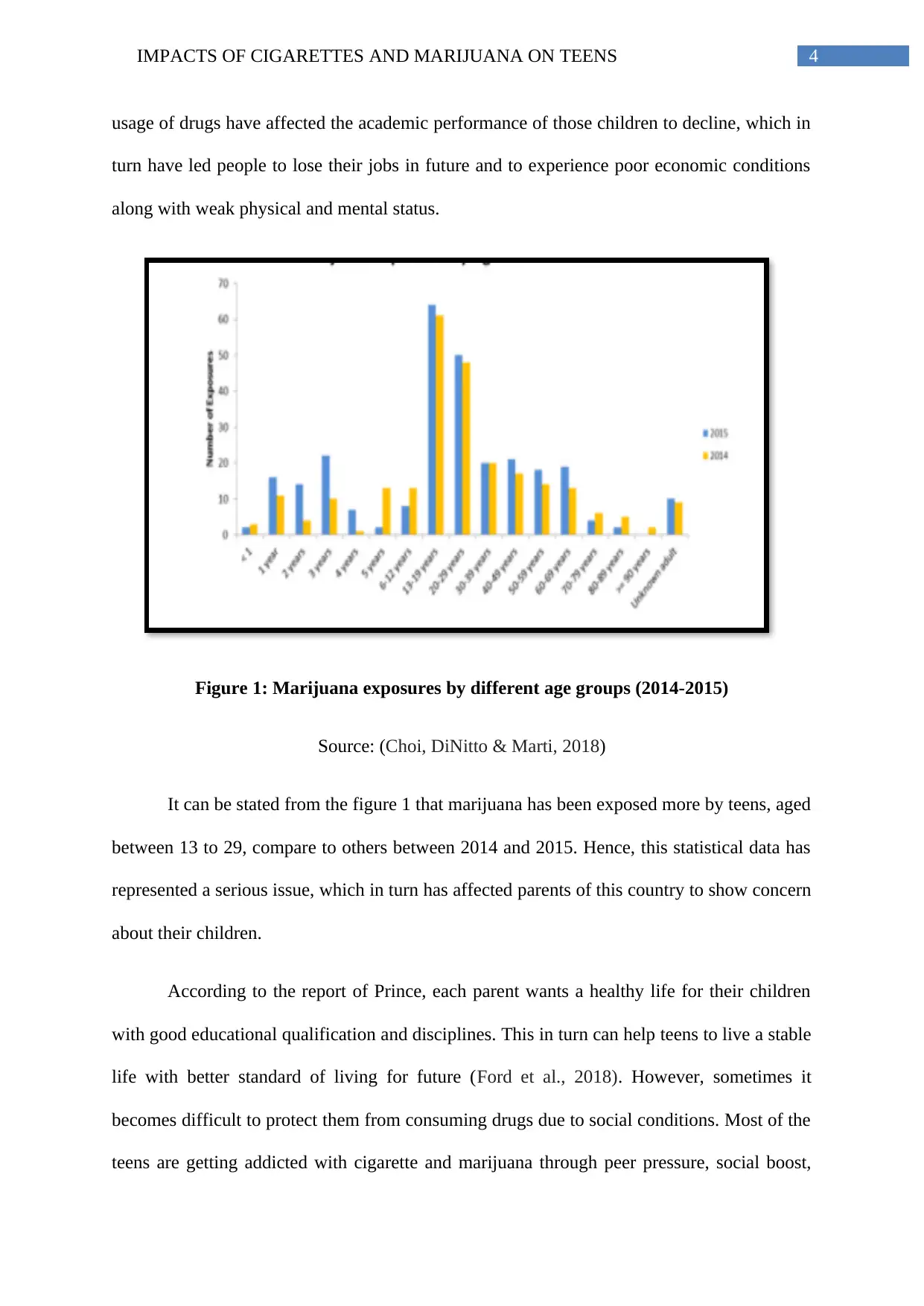
4IMPACTS OF CIGARETTES AND MARIJUANA ON TEENS
usage of drugs have affected the academic performance of those children to decline, which in
turn have led people to lose their jobs in future and to experience poor economic conditions
along with weak physical and mental status.
Figure 1: Marijuana exposures by different age groups (2014-2015)
Source: (Choi, DiNitto & Marti, 2018)
It can be stated from the figure 1 that marijuana has been exposed more by teens, aged
between 13 to 29, compare to others between 2014 and 2015. Hence, this statistical data has
represented a serious issue, which in turn has affected parents of this country to show concern
about their children.
According to the report of Prince, each parent wants a healthy life for their children
with good educational qualification and disciplines. This in turn can help teens to live a stable
life with better standard of living for future (Ford et al., 2018). However, sometimes it
becomes difficult to protect them from consuming drugs due to social conditions. Most of the
teens are getting addicted with cigarette and marijuana through peer pressure, social boost,
usage of drugs have affected the academic performance of those children to decline, which in
turn have led people to lose their jobs in future and to experience poor economic conditions
along with weak physical and mental status.
Figure 1: Marijuana exposures by different age groups (2014-2015)
Source: (Choi, DiNitto & Marti, 2018)
It can be stated from the figure 1 that marijuana has been exposed more by teens, aged
between 13 to 29, compare to others between 2014 and 2015. Hence, this statistical data has
represented a serious issue, which in turn has affected parents of this country to show concern
about their children.
According to the report of Prince, each parent wants a healthy life for their children
with good educational qualification and disciplines. This in turn can help teens to live a stable
life with better standard of living for future (Ford et al., 2018). However, sometimes it
becomes difficult to protect them from consuming drugs due to social conditions. Most of the
teens are getting addicted with cigarette and marijuana through peer pressure, social boost,
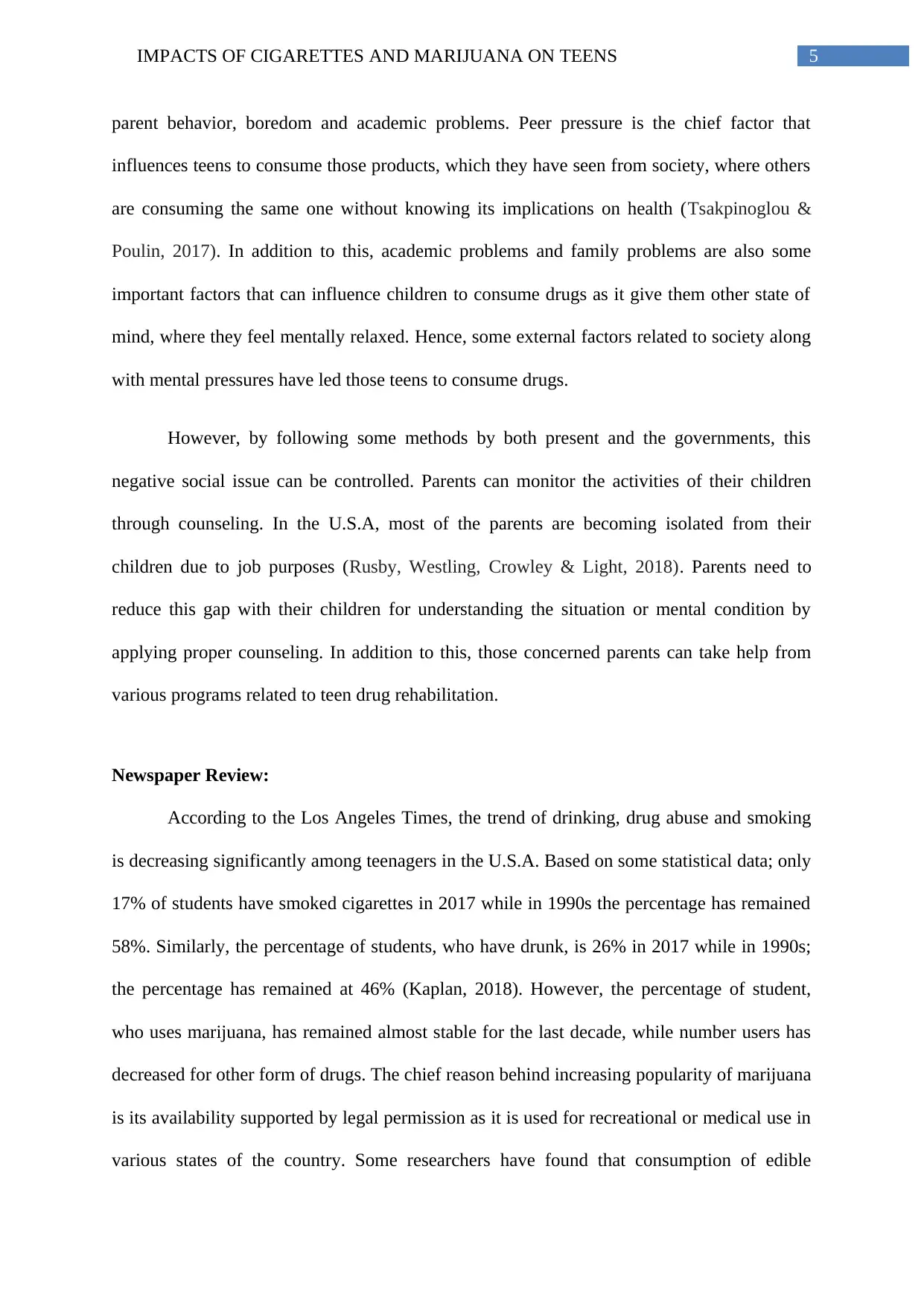
5IMPACTS OF CIGARETTES AND MARIJUANA ON TEENS
parent behavior, boredom and academic problems. Peer pressure is the chief factor that
influences teens to consume those products, which they have seen from society, where others
are consuming the same one without knowing its implications on health (Tsakpinoglou &
Poulin, 2017). In addition to this, academic problems and family problems are also some
important factors that can influence children to consume drugs as it give them other state of
mind, where they feel mentally relaxed. Hence, some external factors related to society along
with mental pressures have led those teens to consume drugs.
However, by following some methods by both present and the governments, this
negative social issue can be controlled. Parents can monitor the activities of their children
through counseling. In the U.S.A, most of the parents are becoming isolated from their
children due to job purposes (Rusby, Westling, Crowley & Light, 2018). Parents need to
reduce this gap with their children for understanding the situation or mental condition by
applying proper counseling. In addition to this, those concerned parents can take help from
various programs related to teen drug rehabilitation.
Newspaper Review:
According to the Los Angeles Times, the trend of drinking, drug abuse and smoking
is decreasing significantly among teenagers in the U.S.A. Based on some statistical data; only
17% of students have smoked cigarettes in 2017 while in 1990s the percentage has remained
58%. Similarly, the percentage of students, who have drunk, is 26% in 2017 while in 1990s;
the percentage has remained at 46% (Kaplan, 2018). However, the percentage of student,
who uses marijuana, has remained almost stable for the last decade, while number users has
decreased for other form of drugs. The chief reason behind increasing popularity of marijuana
is its availability supported by legal permission as it is used for recreational or medical use in
various states of the country. Some researchers have found that consumption of edible
parent behavior, boredom and academic problems. Peer pressure is the chief factor that
influences teens to consume those products, which they have seen from society, where others
are consuming the same one without knowing its implications on health (Tsakpinoglou &
Poulin, 2017). In addition to this, academic problems and family problems are also some
important factors that can influence children to consume drugs as it give them other state of
mind, where they feel mentally relaxed. Hence, some external factors related to society along
with mental pressures have led those teens to consume drugs.
However, by following some methods by both present and the governments, this
negative social issue can be controlled. Parents can monitor the activities of their children
through counseling. In the U.S.A, most of the parents are becoming isolated from their
children due to job purposes (Rusby, Westling, Crowley & Light, 2018). Parents need to
reduce this gap with their children for understanding the situation or mental condition by
applying proper counseling. In addition to this, those concerned parents can take help from
various programs related to teen drug rehabilitation.
Newspaper Review:
According to the Los Angeles Times, the trend of drinking, drug abuse and smoking
is decreasing significantly among teenagers in the U.S.A. Based on some statistical data; only
17% of students have smoked cigarettes in 2017 while in 1990s the percentage has remained
58%. Similarly, the percentage of students, who have drunk, is 26% in 2017 while in 1990s;
the percentage has remained at 46% (Kaplan, 2018). However, the percentage of student,
who uses marijuana, has remained almost stable for the last decade, while number users has
decreased for other form of drugs. The chief reason behind increasing popularity of marijuana
is its availability supported by legal permission as it is used for recreational or medical use in
various states of the country. Some researchers have found that consumption of edible
⊘ This is a preview!⊘
Do you want full access?
Subscribe today to unlock all pages.

Trusted by 1+ million students worldwide
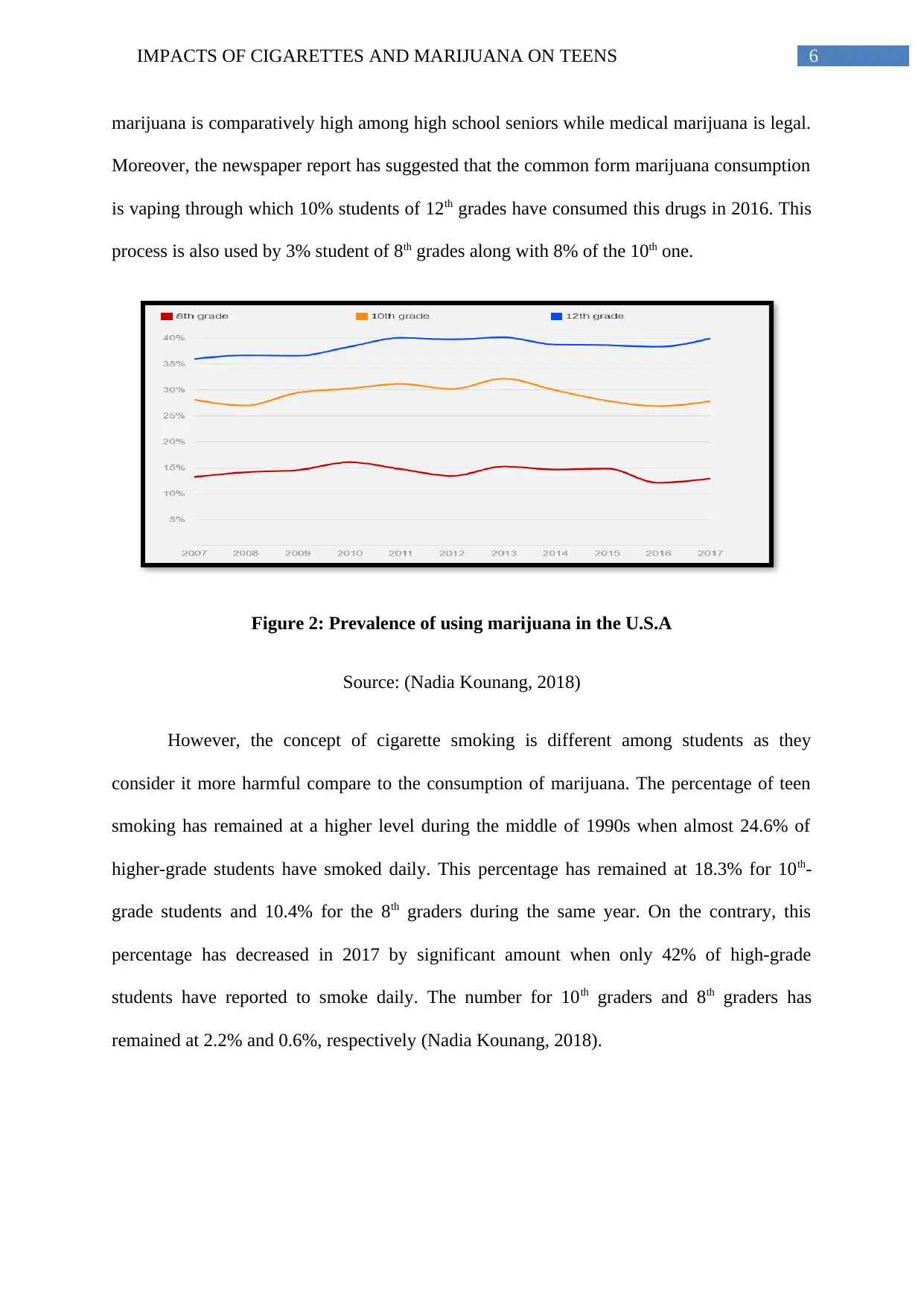
6IMPACTS OF CIGARETTES AND MARIJUANA ON TEENS
marijuana is comparatively high among high school seniors while medical marijuana is legal.
Moreover, the newspaper report has suggested that the common form marijuana consumption
is vaping through which 10% students of 12th grades have consumed this drugs in 2016. This
process is also used by 3% student of 8th grades along with 8% of the 10th one.
Figure 2: Prevalence of using marijuana in the U.S.A
Source: (Nadia Kounang, 2018)
However, the concept of cigarette smoking is different among students as they
consider it more harmful compare to the consumption of marijuana. The percentage of teen
smoking has remained at a higher level during the middle of 1990s when almost 24.6% of
higher-grade students have smoked daily. This percentage has remained at 18.3% for 10th-
grade students and 10.4% for the 8th graders during the same year. On the contrary, this
percentage has decreased in 2017 by significant amount when only 42% of high-grade
students have reported to smoke daily. The number for 10th graders and 8th graders has
remained at 2.2% and 0.6%, respectively (Nadia Kounang, 2018).
marijuana is comparatively high among high school seniors while medical marijuana is legal.
Moreover, the newspaper report has suggested that the common form marijuana consumption
is vaping through which 10% students of 12th grades have consumed this drugs in 2016. This
process is also used by 3% student of 8th grades along with 8% of the 10th one.
Figure 2: Prevalence of using marijuana in the U.S.A
Source: (Nadia Kounang, 2018)
However, the concept of cigarette smoking is different among students as they
consider it more harmful compare to the consumption of marijuana. The percentage of teen
smoking has remained at a higher level during the middle of 1990s when almost 24.6% of
higher-grade students have smoked daily. This percentage has remained at 18.3% for 10th-
grade students and 10.4% for the 8th graders during the same year. On the contrary, this
percentage has decreased in 2017 by significant amount when only 42% of high-grade
students have reported to smoke daily. The number for 10th graders and 8th graders has
remained at 2.2% and 0.6%, respectively (Nadia Kounang, 2018).
Paraphrase This Document
Need a fresh take? Get an instant paraphrase of this document with our AI Paraphraser
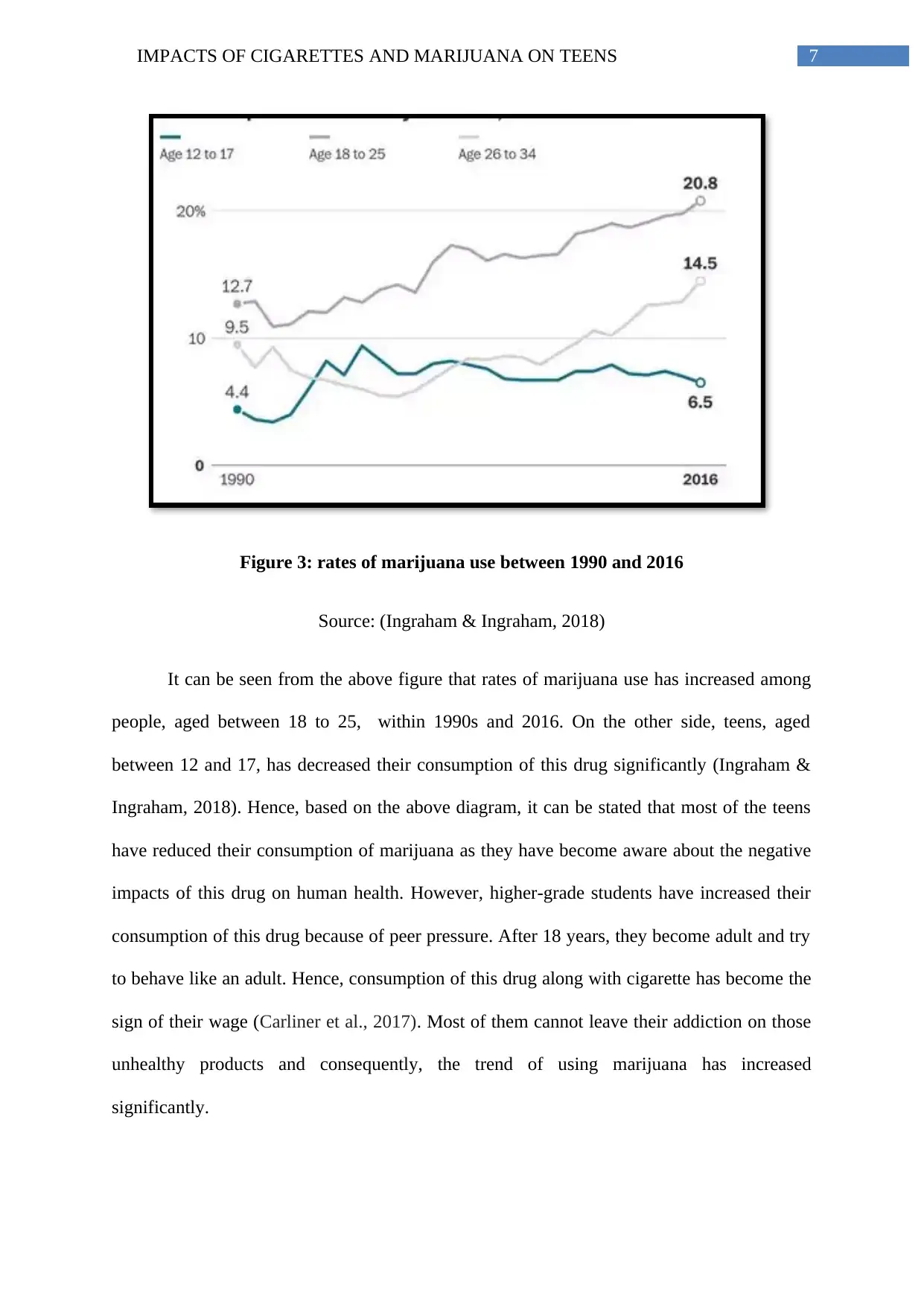
7IMPACTS OF CIGARETTES AND MARIJUANA ON TEENS
Figure 3: rates of marijuana use between 1990 and 2016
Source: (Ingraham & Ingraham, 2018)
It can be seen from the above figure that rates of marijuana use has increased among
people, aged between 18 to 25, within 1990s and 2016. On the other side, teens, aged
between 12 and 17, has decreased their consumption of this drug significantly (Ingraham &
Ingraham, 2018). Hence, based on the above diagram, it can be stated that most of the teens
have reduced their consumption of marijuana as they have become aware about the negative
impacts of this drug on human health. However, higher-grade students have increased their
consumption of this drug because of peer pressure. After 18 years, they become adult and try
to behave like an adult. Hence, consumption of this drug along with cigarette has become the
sign of their wage (Carliner et al., 2017). Most of them cannot leave their addiction on those
unhealthy products and consequently, the trend of using marijuana has increased
significantly.
Figure 3: rates of marijuana use between 1990 and 2016
Source: (Ingraham & Ingraham, 2018)
It can be seen from the above figure that rates of marijuana use has increased among
people, aged between 18 to 25, within 1990s and 2016. On the other side, teens, aged
between 12 and 17, has decreased their consumption of this drug significantly (Ingraham &
Ingraham, 2018). Hence, based on the above diagram, it can be stated that most of the teens
have reduced their consumption of marijuana as they have become aware about the negative
impacts of this drug on human health. However, higher-grade students have increased their
consumption of this drug because of peer pressure. After 18 years, they become adult and try
to behave like an adult. Hence, consumption of this drug along with cigarette has become the
sign of their wage (Carliner et al., 2017). Most of them cannot leave their addiction on those
unhealthy products and consequently, the trend of using marijuana has increased
significantly.
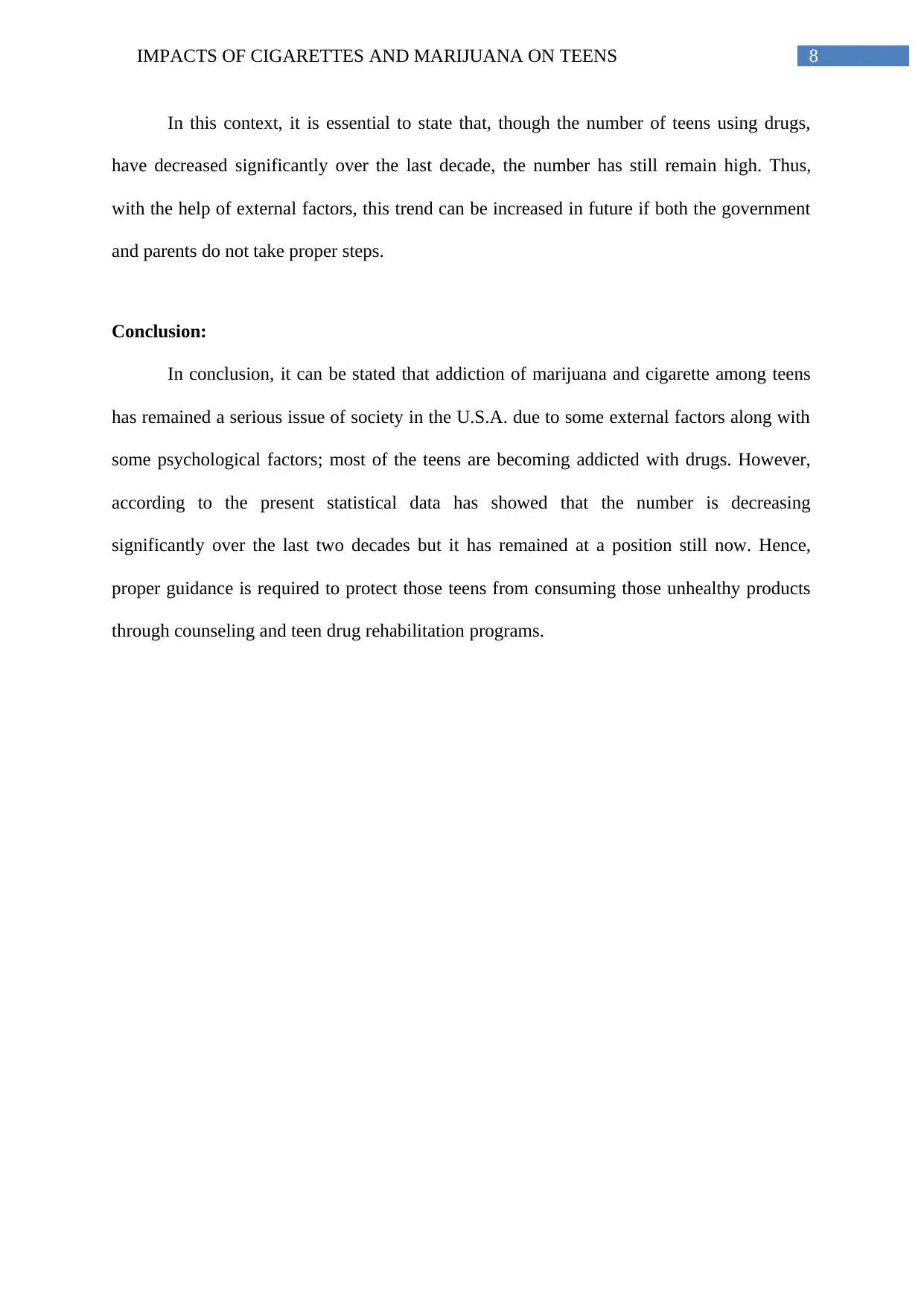
8IMPACTS OF CIGARETTES AND MARIJUANA ON TEENS
In this context, it is essential to state that, though the number of teens using drugs,
have decreased significantly over the last decade, the number has still remain high. Thus,
with the help of external factors, this trend can be increased in future if both the government
and parents do not take proper steps.
Conclusion:
In conclusion, it can be stated that addiction of marijuana and cigarette among teens
has remained a serious issue of society in the U.S.A. due to some external factors along with
some psychological factors; most of the teens are becoming addicted with drugs. However,
according to the present statistical data has showed that the number is decreasing
significantly over the last two decades but it has remained at a position still now. Hence,
proper guidance is required to protect those teens from consuming those unhealthy products
through counseling and teen drug rehabilitation programs.
In this context, it is essential to state that, though the number of teens using drugs,
have decreased significantly over the last decade, the number has still remain high. Thus,
with the help of external factors, this trend can be increased in future if both the government
and parents do not take proper steps.
Conclusion:
In conclusion, it can be stated that addiction of marijuana and cigarette among teens
has remained a serious issue of society in the U.S.A. due to some external factors along with
some psychological factors; most of the teens are becoming addicted with drugs. However,
according to the present statistical data has showed that the number is decreasing
significantly over the last two decades but it has remained at a position still now. Hence,
proper guidance is required to protect those teens from consuming those unhealthy products
through counseling and teen drug rehabilitation programs.
⊘ This is a preview!⊘
Do you want full access?
Subscribe today to unlock all pages.

Trusted by 1+ million students worldwide
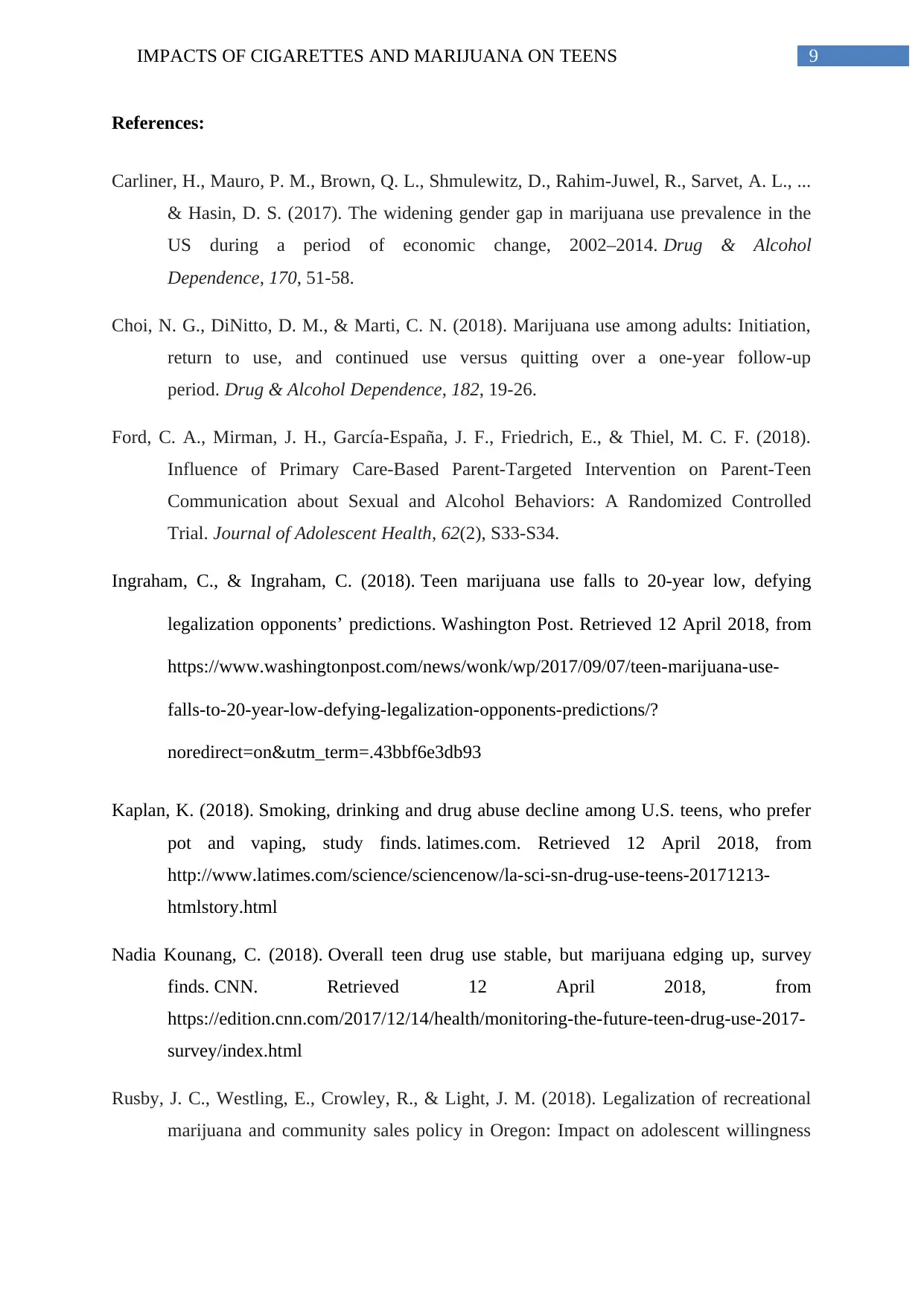
9IMPACTS OF CIGARETTES AND MARIJUANA ON TEENS
References:
Carliner, H., Mauro, P. M., Brown, Q. L., Shmulewitz, D., Rahim-Juwel, R., Sarvet, A. L., ...
& Hasin, D. S. (2017). The widening gender gap in marijuana use prevalence in the
US during a period of economic change, 2002–2014. Drug & Alcohol
Dependence, 170, 51-58.
Choi, N. G., DiNitto, D. M., & Marti, C. N. (2018). Marijuana use among adults: Initiation,
return to use, and continued use versus quitting over a one-year follow-up
period. Drug & Alcohol Dependence, 182, 19-26.
Ford, C. A., Mirman, J. H., García-España, J. F., Friedrich, E., & Thiel, M. C. F. (2018).
Influence of Primary Care-Based Parent-Targeted Intervention on Parent-Teen
Communication about Sexual and Alcohol Behaviors: A Randomized Controlled
Trial. Journal of Adolescent Health, 62(2), S33-S34.
Ingraham, C., & Ingraham, C. (2018). Teen marijuana use falls to 20-year low, defying
legalization opponents’ predictions. Washington Post. Retrieved 12 April 2018, from
https://www.washingtonpost.com/news/wonk/wp/2017/09/07/teen-marijuana-use-
falls-to-20-year-low-defying-legalization-opponents-predictions/?
noredirect=on&utm_term=.43bbf6e3db93
Kaplan, K. (2018). Smoking, drinking and drug abuse decline among U.S. teens, who prefer
pot and vaping, study finds. latimes.com. Retrieved 12 April 2018, from
http://www.latimes.com/science/sciencenow/la-sci-sn-drug-use-teens-20171213-
htmlstory.html
Nadia Kounang, C. (2018). Overall teen drug use stable, but marijuana edging up, survey
finds. CNN. Retrieved 12 April 2018, from
https://edition.cnn.com/2017/12/14/health/monitoring-the-future-teen-drug-use-2017-
survey/index.html
Rusby, J. C., Westling, E., Crowley, R., & Light, J. M. (2018). Legalization of recreational
marijuana and community sales policy in Oregon: Impact on adolescent willingness
References:
Carliner, H., Mauro, P. M., Brown, Q. L., Shmulewitz, D., Rahim-Juwel, R., Sarvet, A. L., ...
& Hasin, D. S. (2017). The widening gender gap in marijuana use prevalence in the
US during a period of economic change, 2002–2014. Drug & Alcohol
Dependence, 170, 51-58.
Choi, N. G., DiNitto, D. M., & Marti, C. N. (2018). Marijuana use among adults: Initiation,
return to use, and continued use versus quitting over a one-year follow-up
period. Drug & Alcohol Dependence, 182, 19-26.
Ford, C. A., Mirman, J. H., García-España, J. F., Friedrich, E., & Thiel, M. C. F. (2018).
Influence of Primary Care-Based Parent-Targeted Intervention on Parent-Teen
Communication about Sexual and Alcohol Behaviors: A Randomized Controlled
Trial. Journal of Adolescent Health, 62(2), S33-S34.
Ingraham, C., & Ingraham, C. (2018). Teen marijuana use falls to 20-year low, defying
legalization opponents’ predictions. Washington Post. Retrieved 12 April 2018, from
https://www.washingtonpost.com/news/wonk/wp/2017/09/07/teen-marijuana-use-
falls-to-20-year-low-defying-legalization-opponents-predictions/?
noredirect=on&utm_term=.43bbf6e3db93
Kaplan, K. (2018). Smoking, drinking and drug abuse decline among U.S. teens, who prefer
pot and vaping, study finds. latimes.com. Retrieved 12 April 2018, from
http://www.latimes.com/science/sciencenow/la-sci-sn-drug-use-teens-20171213-
htmlstory.html
Nadia Kounang, C. (2018). Overall teen drug use stable, but marijuana edging up, survey
finds. CNN. Retrieved 12 April 2018, from
https://edition.cnn.com/2017/12/14/health/monitoring-the-future-teen-drug-use-2017-
survey/index.html
Rusby, J. C., Westling, E., Crowley, R., & Light, J. M. (2018). Legalization of recreational
marijuana and community sales policy in Oregon: Impact on adolescent willingness
Paraphrase This Document
Need a fresh take? Get an instant paraphrase of this document with our AI Paraphraser
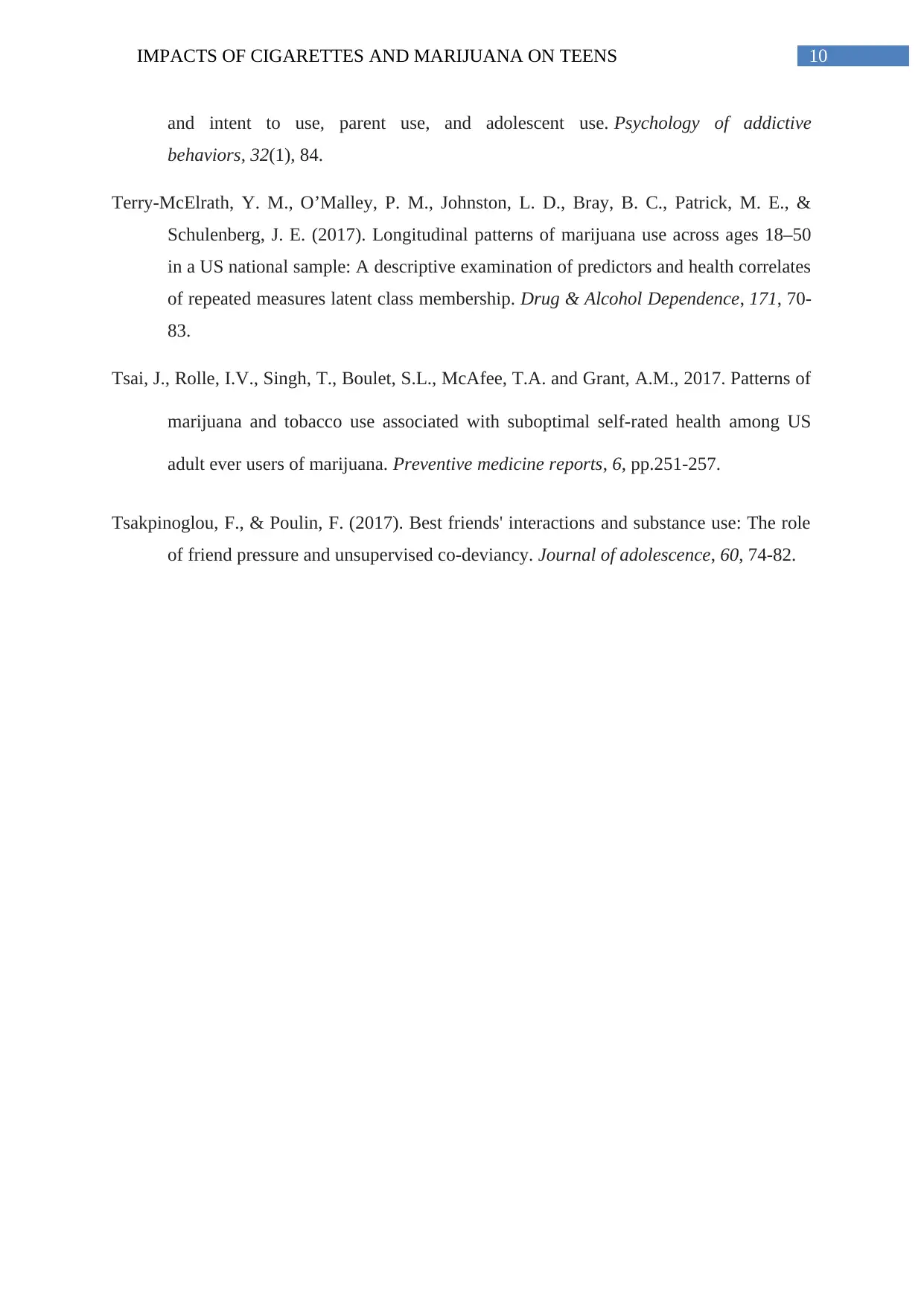
10IMPACTS OF CIGARETTES AND MARIJUANA ON TEENS
and intent to use, parent use, and adolescent use. Psychology of addictive
behaviors, 32(1), 84.
Terry-McElrath, Y. M., O’Malley, P. M., Johnston, L. D., Bray, B. C., Patrick, M. E., &
Schulenberg, J. E. (2017). Longitudinal patterns of marijuana use across ages 18–50
in a US national sample: A descriptive examination of predictors and health correlates
of repeated measures latent class membership. Drug & Alcohol Dependence, 171, 70-
83.
Tsai, J., Rolle, I.V., Singh, T., Boulet, S.L., McAfee, T.A. and Grant, A.M., 2017. Patterns of
marijuana and tobacco use associated with suboptimal self-rated health among US
adult ever users of marijuana. Preventive medicine reports, 6, pp.251-257.
Tsakpinoglou, F., & Poulin, F. (2017). Best friends' interactions and substance use: The role
of friend pressure and unsupervised co-deviancy. Journal of adolescence, 60, 74-82.
and intent to use, parent use, and adolescent use. Psychology of addictive
behaviors, 32(1), 84.
Terry-McElrath, Y. M., O’Malley, P. M., Johnston, L. D., Bray, B. C., Patrick, M. E., &
Schulenberg, J. E. (2017). Longitudinal patterns of marijuana use across ages 18–50
in a US national sample: A descriptive examination of predictors and health correlates
of repeated measures latent class membership. Drug & Alcohol Dependence, 171, 70-
83.
Tsai, J., Rolle, I.V., Singh, T., Boulet, S.L., McAfee, T.A. and Grant, A.M., 2017. Patterns of
marijuana and tobacco use associated with suboptimal self-rated health among US
adult ever users of marijuana. Preventive medicine reports, 6, pp.251-257.
Tsakpinoglou, F., & Poulin, F. (2017). Best friends' interactions and substance use: The role
of friend pressure and unsupervised co-deviancy. Journal of adolescence, 60, 74-82.
1 out of 11
Related Documents
Your All-in-One AI-Powered Toolkit for Academic Success.
+13062052269
info@desklib.com
Available 24*7 on WhatsApp / Email
![[object Object]](/_next/static/media/star-bottom.7253800d.svg)
Unlock your academic potential
Copyright © 2020–2025 A2Z Services. All Rights Reserved. Developed and managed by ZUCOL.





